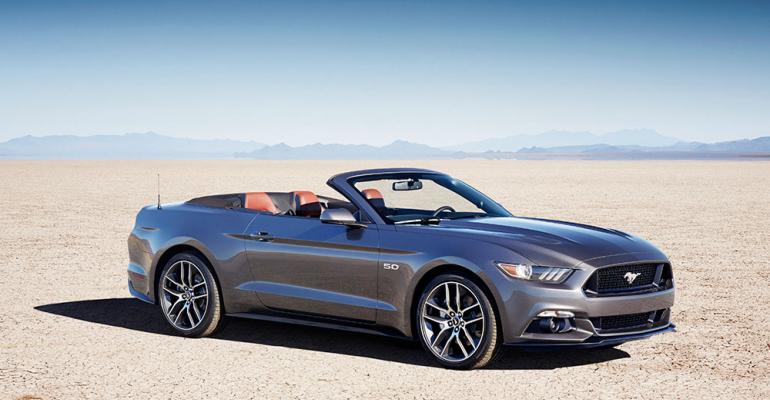ALLEN PARK, MI – Before the all-new ’15 Ford Mustang was unveiled last year, there was rampant speculation the pony car closely would resemble the Evos concept shown at the 2011 Frankfurt auto show.
Pundits speculated the sleek lines of the concept would give the Mustang a more modern look and make it more appealing to European consumers, where the new car was to be introduced.
In reality, a production version of the Evos never was in the plans for Mustang, says Steve Ling, North American marketing manager.
The Evos “wasn’t supposed to be any tease for Mustang at all,” Ling tells WardsAuto at a media event here. “I think it was rather misinterpreted and never entered into our thoughts.”
Rather, Ling and his team always planned to carry forth iconic Mustang design cues to the new model, including the tri-bar taillamps, a long hood and short decklid.
While carrying on Mustang’s rich design heritage was important, it also was critical the new model looks different enough from prior generations to garner attention from both current owners and those new to the marque, Ling says.
“When I spoke to the most ardent Mustang fans they loved the car, but they were ready for it to move on. They were ready for a change,” he says. “From a sales standpoint, we have a large group of customers that love this brand, but they probably own one or two or more, so you have to get them to buy another one.
“If it’s not different enough in performance, technology and overall looks, they’re very happy with what they have,” Ling says, adding the design also had to draw new buyers.
Although the new Mustang will be sold in markets outside the U.S., Ling says the pony car at heart is a North American product, and consumer workshops indicated that even overseas customers longed for the U.S. version.
“The big thing is it’s not a global car. It’s a car developed for here that we’re now taking globally, and there’s a difference,” he says. “All around the world we got that feedback, including from our dealers, that they didn’t want it to be Euro-ized. They wanted the American Mustang. So that made it easy for us.”
The new Mustang sits lower and is wider than its predecessor. Attention also was paid to aerodynamics. Ford says the new model will have a lower drag coefficient than the current generation due to its redesigned hood, decklid and wheel aero curtains that guide airflow across the front wheels.
Additionally, the grille is designed to allow air to flow through the engine bay instead of directing it around the sides and over the top of the body, which increases drag.
To streamline the convertible version, a new top was designed with supplier partner Webasto. The new convertible roof gets a full fabric outer layer and a full inner headliner. A more compact lowering mechanism allows the roof to fold flatter than the previous version, reducing aero drag when driving with the top down.
The ’15 Mustang, which hits U.S. showrooms this fall, will roll out in Europe in first-half 2015 and in the Asia-Pacific region in the second half of the year.
In the U.S., the Mustang will be offered with a base 3.7L V-6 delivering 300 hp and 270 lb.-ft. (366 Nm) of torque. The EcoBoost 2.3L 4-cyl. will mark a step up, at more than 305 hp and better than 300 lb.-ft. (407 Nm) of torque, the automaker says.
Topping the line will be a 5.0L V-8, rated at more than 420 hp and 390 lb.-ft. (529 Nm) of torque. Although a carryover, Ford says it made several improvements to the 5.0L engine, including larger intake and exhaust valves, revised camshafts, stiffer valve springs, a new cylinder head, sinter-forged connecting rods, redesigned pistons and a rebalanced crankshaft for higher-speed operation.
International markets will offer only the 4-cyl., which is the first Ford engine to get a low-inertia twin-scroll turbocharger, and the V-8.
Perhaps the biggest mechanical deviation from the current model is the addition of an independent rear suspension. For years the Mustang had a solid rear axle, which limited ride comfort and handling.
Although the Mustang’s archrival, the Chevrolet Camaro, adopted IRS when the new body style bowed in 2009, pony-car purists insisted a solid axle was the perfect fit for the Mustang.
“The capability of the car was phenomenal, even when you took it onto a race course,” Ling says. “But we felt at this point we had taken the technology as far as it could go. We were going to do a new suspension anyway, so moving to IRS was deemed a logical decision.”
Ling says the new car will handle better with the new suspension setup, which allows for larger rear tires, brakes and a lower stance. Although the IRS costs more than a solid rear axle, he says the cost was mitigated because it was a global car to be sold in larger volumes than the current model.
“Keeping affordability in the Mustang is absolutely key,” he says. “We think this is the right call for cost as well as capability.”





